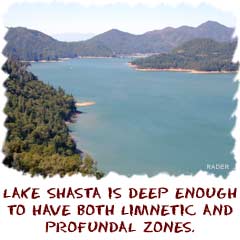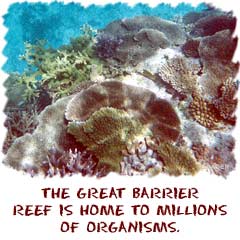Freshwater Biomes
 Let's start with standing freshwater biomes, from a river to a lake or pond. The water doesn't move very quickly here. It gives animals a chance to grow up. You'll find larger fish, insects, and plants in this lake. Scientists divide lakes into two major levels, limnetic (the top), and profundal (the deeper part). They even have names for the shore (littoral) and the very bottom on the floor of the lake (benthic). You'll find most of the activity in the limnetic zone. Fishermen often fish in the limnetic zone.
Let's start with standing freshwater biomes, from a river to a lake or pond. The water doesn't move very quickly here. It gives animals a chance to grow up. You'll find larger fish, insects, and plants in this lake. Scientists divide lakes into two major levels, limnetic (the top), and profundal (the deeper part). They even have names for the shore (littoral) and the very bottom on the floor of the lake (benthic). You'll find most of the activity in the limnetic zone. Fishermen often fish in the limnetic zone.
Salty And Fresh Water Mixing
Estuaries are the regions where the freshwater meets the saltwater. They will always be found near the coast. Fresh and saltwater mix constantly in estuaries. This mixing allows huge amounts of marine life to exist. It turns out that this is a great area for fish to lay their eggs. The water is quiet and still and when the fish are tiny, they can hide in the cloudy (brackish) water. When you look around you will see all sorts of birds such as cranes and storks and insects who lay their eggs near the still water also.
Right Around The Coasts
The intertidal zone is where the waves hit the coast. Tides are controlled by the gravity of the Moon. The Moon causes them to move up and down each day. As they rise and fall they leave a patch of coast under the water when the tide is high. The same area is dry and exposed when the tide lowers. It's usually very rocky here with lots of algae and small creatures. You can walk around when the tide is low and find sea urchins, sea stars, and all sorts of birds and insects looking for food with you.Next to the intertidal zones are subtidal zones. This zone is always under water along the coasts of continents. You can find coral reefs and most of the world's fish in this region. You'll also find larger fish because they have more room to swim and more little fish to eat. There are also huge sandy plains in this subtidal region. Because of all of the waves and activity, there is a lot of oxygen in the water to support the wildlife.
Deep In The Ocean
There comes a point where the floor of the ocean just drops away. Now you are in the deep ocean biome. Scientists break this biome into three layers. At the surface is the euophotic zone. There is a large amount of sunlight and oxygen but very few nutrients. They all fall to the bottom of the ocean. You'll find many small organisms that are photosynthetic. As we move down, we get to the bathyal zone. The light is very dim. No little organisms are found here, just some fish who feed on the organisms at the surface. At the bottom of the ocean is the abyssal zone. This zone is pitch black, with no producers, little oxygen, extremely cold, and high pressure. There are living organisms down there. They usually feed on the dead stuff that falls from the surface layers. Then, of course, there are the predators that swim through the murky depths.
Or search the sites for a specific topic.
- Overview
- Freshwater
- Groundwater
- Groundwater Use
- Seawater
- Wetland Biomes
- More Aquatic Biomes
- Clouds
- More Topics

Impacts of Hurricanes on Wetlands (USGS Video)

Useful Reference Materials
Encyclopedia.com (Biomes):http://www.encyclopedia.com/topic/Biomes.aspx
Encyclopedia.com (Estuary):
http://www.encyclopedia.com/topic/Estuaries.aspx
Wikipedia (Biomes):
http://en.wikipedia.org/wiki/Biome
Wikipedia (Aquatic Ecosystems):
http://en.wikipedia.org/wiki/Aquatic_ecosystem
Encyclopædia Britannica (Wetland Ecology):
http://www.britannica.com/EBchecked/topic/75627/boundary-ecosystem/70764/Wetland-ecology





